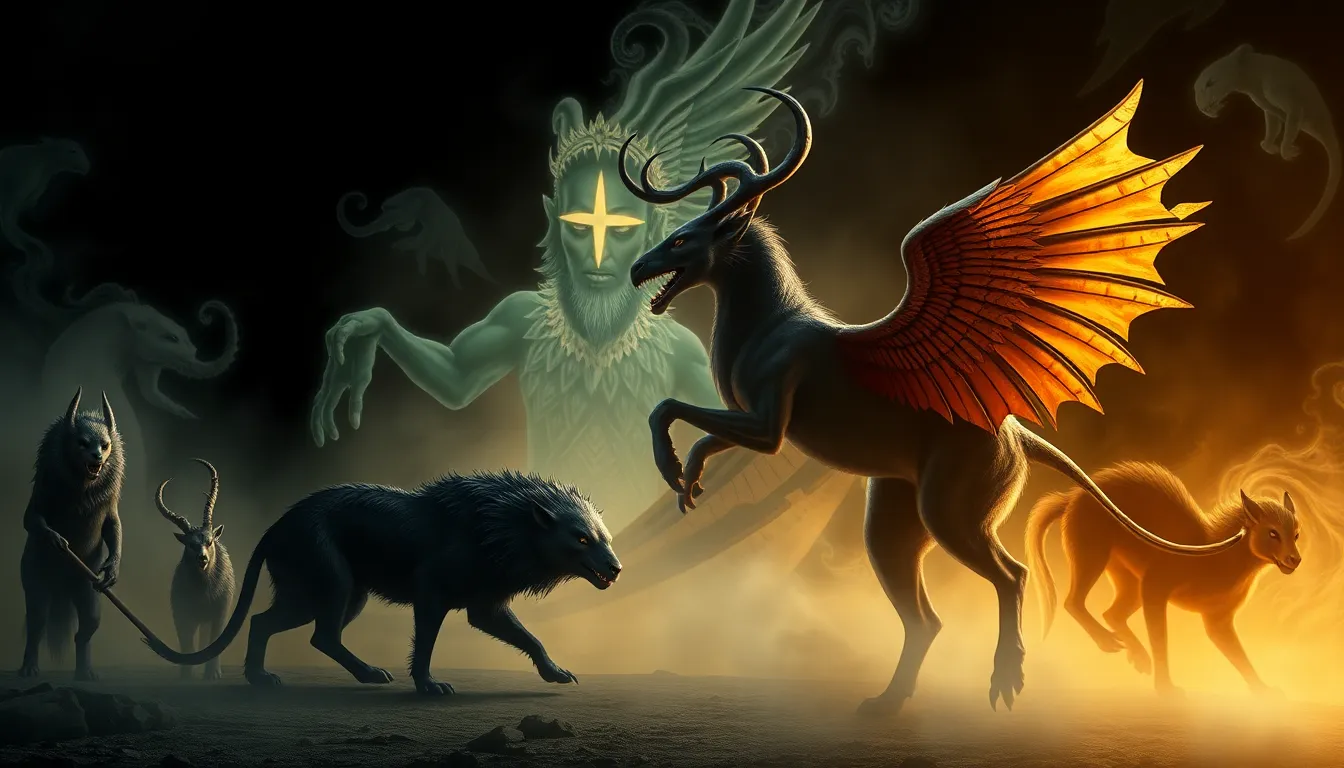The Great Flood: Myths That Challenge Our Understanding of History
I. Introduction
The Great Flood is a significant narrative found in various cultures around the world, often symbolizing destruction, renewal, and the power of nature. It is typically depicted as a catastrophic event that led to the near annihilation of humanity or a specific group of people, with a few chosen individuals or species surviving. The significance of the Great Flood in mythology and religion lies in its ability to convey moral lessons, cultural values, and historical reflections. This article aims to explore various myths surrounding the Great Flood and their historical implications, shedding light on how these stories shape our understanding of past civilizations and their responses to natural disasters.
II. The Great Flood in Ancient Civilizations
A. The Epic of Gilgamesh: An early account of a great flood
The Epic of Gilgamesh, one of the oldest known pieces of literature, originates from ancient Mesopotamia. It recounts the story of Utnapishtim, who was warned by the god Ea about an impending flood meant to wipe out humanity. Utnapishtim builds a large boat, saving his family and various species of animals. This tale not only serves as an early flood narrative but also emphasizes themes of mortality and the quest for immortality.
B. The Biblical Flood: Insights from the Book of Genesis
The Great Flood is perhaps most famously known through the Biblical account in the Book of Genesis. In this narrative, God decides to flood the Earth to cleanse it of human wickedness, sparing only Noah, his family, and pairs of every animal species on the Ark. This story highlights themes of divine judgment, obedience, and covenant, as God promises never to destroy the Earth by flood again, symbolized by the rainbow.
C. The Hindu account: Matsya and the great deluge
In Hindu mythology, the story of Matsya, the fish incarnation of the god Vishnu, offers an account of a great flood that cleanses the world of sin. Matsya warns King Manu of the impending disaster, instructing him to build a boat and save the seeds of all life. This narrative reflects the importance of dharma (righteousness) and the cyclical nature of creation and destruction in Hindu belief.
III. Comparative Analysis of Flood Myths
A. Similarities in flood narratives across cultures
- Many cultures describe a divine being or beings initiating the flood.
- Survivors often receive specific instructions to build a vessel or take precautions.
- Post-flood, there is usually a renewal of life or a rebirth of the world.
B. Differences in the portrayal of deities and moral lessons
While the general structure of flood myths often shares similarities, the portrayal of deities and the lessons derived from these narratives can differ significantly. In some myths, deities appear as vengeful entities, while in others, they embody mercy and protection. These differences reflect the cultural values and societal norms of the civilizations from which they originate.
C. The role of geography in shaping flood stories
Geography plays a crucial role in shaping flood narratives. Civilizations located near rivers, such as the Tigris, Euphrates, Nile, and Indus, experienced seasonal flooding, which could have influenced their mythological accounts. These floods would have been seen as both a source of fertility and a devastating force, prompting the creation of stories that encapsulate these dualities.
IV. The Historical Context of Flood Myths
A. Archaeological evidence of ancient floods
Archaeological findings indicate that large-scale flooding events occurred in various regions, corroborating some aspects of flood myths. For example, sediment layers in Mesopotamia reveal evidence of significant flooding during the late prehistoric period, suggesting that such events may have inspired the flood narratives recorded in ancient texts.
B. The impact of climate change and natural disasters on early societies
Natural disasters, including floods, significantly impacted early societies, leading to migrations, changes in settlement patterns, and even the collapse of civilizations. These experiences likely contributed to the development of flood myths, serving as cautionary tales and reflections on human vulnerability in the face of nature’s might.
C. How historical events may have influenced myth creation
- Localized flooding could have been exaggerated over time to create a grand narrative.
- Societal trauma from disasters may have led to the creation of myths as a means of understanding and coping.
- Historical events often become intertwined with cultural identity, influencing the portrayal of deities and moral lessons.
V. The Role of Oral Tradition and Storytelling
A. The transmission of flood myths through generations
Oral tradition has played a vital role in preserving flood myths across cultures. These stories were passed down through generations, often evolving in response to the changing contexts of the societies that told them. The oral nature of these narratives allowed for flexibility and adaptation, ensuring their relevance over time.
B. The influence of oral history on written records
The transition from oral to written forms of storytelling helped solidify these myths in historical texts. However, the nuances and variations present in oral traditions often get lost, leading to a more standardized version of the myth that may not reflect the original storytelling practices.
C. The purpose of myths in cultural identity and cohesion
Flood myths serve not only as narratives of disaster but also as vital components of cultural identity. They provide a shared history and moral framework that can foster a sense of community and belonging among people. These stories often convey values and lessons that resonate with the experiences of the society, reinforcing cultural cohesion.
VI. Scientific Perspectives on Flood Myths
A. Geological evidence supporting the occurrence of massive floods
Geological studies have uncovered evidence of significant flooding events throughout history. These findings, such as the discovery of ancient floodplains and sediment deposits, lend credence to the idea that real floods could have inspired the creation of flood myths in various cultures.
B. Theories on the origin of flood myths from a scientific viewpoint
Scientists propose several theories regarding the origins of flood myths, including the possibility of catastrophic events like tsunamis or glacial meltwaters that could have led to widespread flooding. These events may have been localized but were perceived as monumental by the cultures affected.
C. The intersection of mythology and historical geology
The interplay between mythology and geology presents an intriguing field of study. Understanding the geological context of a region can provide insights into the myths that emerged from it, revealing how natural events shaped cultural narratives and beliefs.
VII. The Great Flood and Cultural Symbolism
A. The flood as a metaphor for rebirth and regeneration
The Great Flood often symbolizes rebirth and regeneration, representing the notion that destruction can pave the way for new beginnings. This theme resonates across various cultures, highlighting the cyclical nature of life and the potential for renewal following devastation.
B. Flood narratives as reflections of societal fears and values
Flood myths frequently mirror societal anxieties related to morality, divine retribution, and the unpredictability of nature. These stories reflect the values of the cultures that created them, serving as cautionary tales about the consequences of human actions.
C. The Great Flood in modern literature and art
Modern literature and art continue to draw upon the symbolism of the Great Flood, exploring themes of survival, redemption, and the human condition. These narratives often reinterpret ancient myths, making them relevant to contemporary audiences while preserving their core messages.
VIII. Debunking Common Misconceptions
A. Myths versus facts: Clarifying historical inaccuracies
Many misconceptions exist around flood myths, often due to sensationalized interpretations in popular culture. It is essential to differentiate between the mythological aspects and historical facts to gain a clearer understanding of these narratives and their origins.
B. The impact of popular media on the perception of flood myths
Popular media, including films and novels, often dramatize flood myths, leading to distorted perceptions. These representations can overshadow the original stories’ cultural significance and moral lessons, reducing complex narratives to mere entertainment.
C. How misunderstandings can shape cultural beliefs
Misunderstandings related to flood myths can perpetuate cultural beliefs and stereotypes. It is crucial to approach these stories with an informed perspective, recognizing their historical and cultural contexts to foster a greater understanding of their significance.
IX. Contemporary Relevance of Flood Myths
A. The influence of climate change on modern flood narratives
As climate change leads to more frequent and severe flooding events worldwide, contemporary narratives may evolve to reflect these realities. Modern flood myths may serve as warnings or reflections of societal fears regarding



